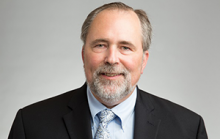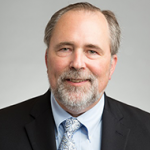The healthcare industry is being rapidly transformed by technology in a multitude of ways – from how doctors engage with patients to how cures are discovered. Boston-based Partners HealthCare is getting ahead of these shifts by collaborating with GE Healthcare and Nvidia to strategically integrate artificial intelligence and machine learning technology into every aspect of patient care over the next 10 years.

Partners Healthcare CIO James Noga recently took home the Leadership Award from the Boston CIO Leadership Association. We caught up with Noga to find out what excites him most about the future of healthcare IT and how he infuses the spirit of discovery throughout his IT organization.
The Enterprisers Project (TEP): What are the biggest changes you’re seeing in healthcare technology, and how are you personally staying on top of innovation? How are you encouraging your team to stay current, as well?

Noga: The big shifts in healthcare technology are really focused in three areas. One is patient engagement outside of traditional medical facilities, whether that’s in their home, their office, or elsewhere. What that means for IT is an increasing need for mobile and wireless support and applications, as well as the integration of the Internet of Things for things like blood pressure cuffs, scales, and wearables. Being able to digest all that data and then engage the patient and their families through mobile applications on the smartphone is a real challenge and opportunity for healthcare. It also encompasses collaboration technology, which enables e-visits – a huge shift in healthcare at the moment.
The second area is analytics. Healthcare is really stepping up its analytics game not only to support clinical and business operations, but more importantly, to support discovery and what I would call “advanced clinical care.” We’re starting to delve into the world of machine-learning and artificial intelligence by opening up a clinical data science center in partnership with GE. The goal is to make discoveries that are really impossible with the human mind alone. We’re starting with imaging because no matter how advanced monitors become, at some point, the human eye can’t perceive the differences. Machine-learning and AI can pick up patterns in images that are guiding radiologists to find those anomalies or abnormalities they couldn’t detect themselves.
The third component is around genetics and genomics. There’s a concept called “gene therapy 2.0,” where genetics and genomics are used to not only to identify potential diseases, but actually modify the DNA to cure those diseases. There were some failures decades ago that really stalled this practice, but now many of the obstacles have been overcome. There are currently about 50 diseases that are under intense investigation as to whether gene therapy can actually help with a cure. It’s very exciting to think about the possibilities in this area of healthcare.
We strive to stay on top of these innovations through the obvious channels – peer networks, reading materials, research from Gartner and Forrester, conferences, etc. Beyond that, I make sure my entire staff is always in a listening mode, and that we don’t discount anything as a possibility. As a result, we take a few risks in terms of proof of concepts. Some of those succeed and some of those fail. But it becomes a learning opportunity regardless.
TEP: What excites you most about the potential of AI in healthcare?
Noga: It’s not just the potential for discovery that is exciting. It’s also about enhancing clinical decision support. What we’re talking about now is taking it from the bench to the bedside. And what that really means is once you’ve done the discovery, then how do you apply that in the clinical setting to advance patient care? That’s the exciting piece of the puzzle for me. And then, going a step further, whatever we learn about clinical discovery, we have to then explore – how can we apply that to other business components, whether it’s administrative, efficiency, or something else? We’re at a point where we don’t actually know everything that AI and machine-learning can address, but we’re excited by the vast possibilities that lie ahead.
TEP: How are you keeping the mission of IT top of mind with your entire organization and helping them feel connected to it?
Noga: Our mission is around clinical care, discovery, teaching the next generation of healthcare providers, and serving our communities. It has become part of the culture of IT. If you walked up to anyone in our organization and asked, “What’s our mission?” nine out of 10 could state it accurately. We start talking about the fact that we’re a mission-driven organization while we are hiring. And that’s important because a lot of the talent we bring in could be working at Fortune 500 companies, getting paid substantially more. Focusing on the mission really helps everyone embrace the vision, our purpose, and shared goals.
To further reinforce this, we often invite healthcare providers in to talk about how IT is supporting their ability to provide world-class clinical care. They’ll describe, for example, how a clinical decision support role had an extremely positive outcome for patients that might otherwise have been missed without the support of IT technologies. It’s one of the ways I make sure that IT isn’t seen as this department off to the side, but rather that IT is a critical component in delivering care.
TEP: If you could give one piece of leadership advice that you’ve learned over your career, what would it be?
Noga: Respect every individual. Understand that diversity is a positive aspect of the workplace, and you really need to modify your leadership style based on the team or the person that you’re working with. An important component of that is more listening, less talking – be attuned to the needs of the specific setting you are in. For instance, providing leadership for a project that is going well is fairly simple. Providing leadership for a project that isn’t going so well means putting in place a quick escalation process for a decision. Providing leadership in a crisis requires a lot of transparency and communication. You have to adapt.
Beyond that, I think leadership is understanding what motivates individuals. For some, it’s recognition. For some, it’s how are they monetarily compensated. For others, it’s title. And for others, it’s the work that they’re doing and how connected to it they feel. There is no one single piece of advice for leaders. It’s really just saying, “I’m willing to make decisions. I’m willing to take risks. I understand the organization. I respect every individual. And we know we’re going to deal with both opportunities as well as challenges.”
TEP: What is one of the most important relationships in your current role, and how do you maintain it?
Noga: The most important relationship in my current role is the relationship in the moment. Whether I’m working with a team or with an executive, whether I’m talking to the CEO, or saying “hello” to the environmental services worker, being in the moment is what matters. It’s the most important relationship on a continuous basis.






